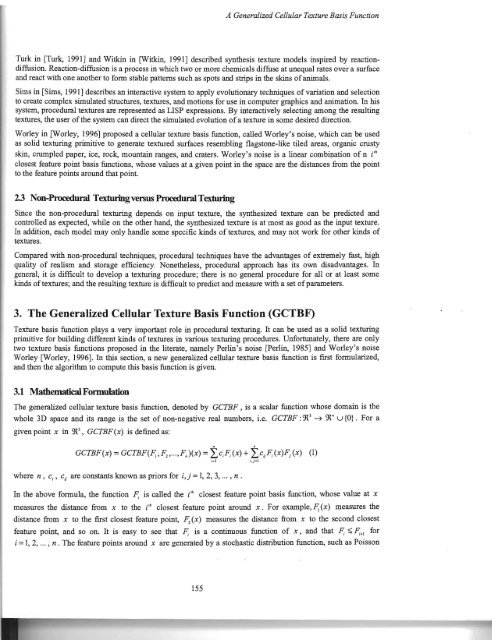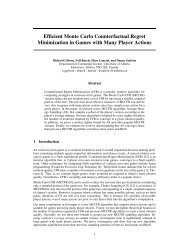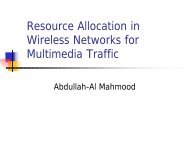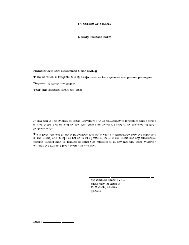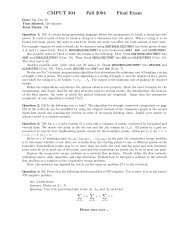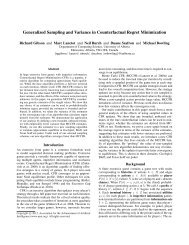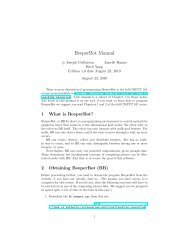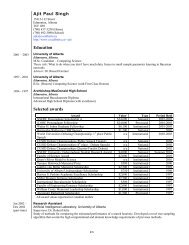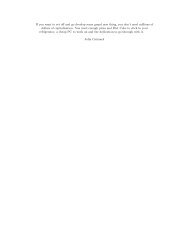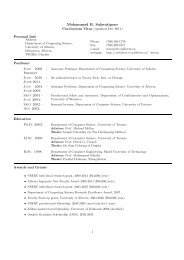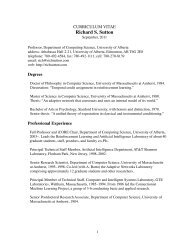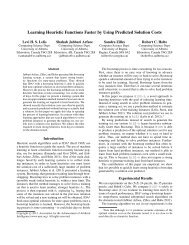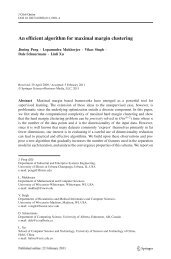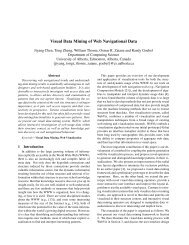Here - Webdocs Cs Ualberta
Here - Webdocs Cs Ualberta
Here - Webdocs Cs Ualberta
- No tags were found...
You also want an ePaper? Increase the reach of your titles
YUMPU automatically turns print PDFs into web optimized ePapers that Google loves.
A Generalized Cellular Texture Basis Function<br />
Turk in (Turk, 1991] and Witkin in (Witkin, 1991] described synthesis texture models inspired by reactiondiffusion.<br />
Reaction-diffusion is a process in which two or more chemicals diffuse at unequal rates over a surface<br />
and react with one another to form stable patterns such as spots and strips in the skins of animals.<br />
Sims in (Sims, 1991] describes an interactive system to apply evolutionary techniques of variation and selection<br />
to create complex simulated structures, textures, and motions for use in computer graphics and animation. In his<br />
system, procedural textures are represented as LISP expressions. By interactively selecting among the resulting<br />
textures, the user of the system can direct the simulated evolution of a texture in some desired direction.<br />
Worley in (Worley, 1996] proposed a cellular texture basis function, called Worley's noise, which can be used<br />
as solid texturing primitive to generate textured surfaces resembling flagstone-like tiled areas, organic crusty<br />
skin, crumpled paper, ice, rock, mountain ranges, and craters. Worley's noise is a linear combination of n if"<br />
closest feature point basis functions, whose values at a given point in the space are the distances from the point<br />
to the feature points around that point.<br />
2.3 Non-Procedural Texturing versus Procedural Texturing<br />
Since the non-procedural texturing depends on input texture, the synthesized texture can be predicted and<br />
controlled as expected, while on the other hand, the synthesized texture is at most as good as the input texture.<br />
In addition, each model may only handle some specific kinds of textures, and may not work for other kinds of<br />
textures.<br />
Compared with non-procedural techniques, procedural techniques have the advantages of extremely fast, high<br />
quality of realism and storage efficiency. Nonetheless, procedural approach has its own disadvantages. In<br />
general, it is difficult to develop a texturing procedure; there is no general procedure for all or at least some<br />
kinds of textures; and the resulting texture is difficult to predict and measure with a set of parameters.<br />
3. The Generalized Cellular Texture Basis Function (GCTBF)<br />
Texture basis function plays a very important role in procedural texturing. It can be used as a solid texturing<br />
primitive for building different kinds of textures in various texturing procedures. Unfortunately, there are only<br />
two texture basis functions proposed in the literate, namely Perlin's noise (Perlin, 1985] and Worley's noise<br />
Worley [Worley, 1996]. In this section, a new generalized cellular texture basis function is first formularized,<br />
and then the algorithm to compute this basis function is given.<br />
3.1 Mathematical Formulation<br />
The generalized cellular texture basis function, denoted by GCTBF, is a scalar function whose domain is the<br />
whole 3D space and its range is the set of non-negative real numbers, i.e . . GCTBF: 9\3 ~ 9\+ u {O}. For a<br />
given point x in 9\3, GCTBF(x) is defined as:<br />
GCTBF(x) =GCTBF(F; ,F 2<br />
, •••,FJ(x) =~>;F;(x) + '~>ij1\(x)Fj(x) (1)<br />
i=-l<br />
i,)=1<br />
where n, C;, Clf are constants known as priors for i,j = 1,2,3, ... , n .<br />
In the above formula, the function 1\ is called the if" closest feature point basis function, whose value at x<br />
measures the distance from x to the t" closest feature point around x. For example, F.. (x) measures the<br />
distance from x to the first closest feature point, F; (x) measures the distance from x to the second closest<br />
feature point, and so on. It is easy to see that 1\ is a continuous function of x, and that F.. ::; F..+I<br />
for<br />
i = 1, 2, ... , n . The feature points around x are generated by a stochastic distribution function, such as Poisson<br />
155


